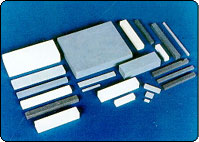
Honing is the finishing
of internal dimensions of automobile cylinder heads
and other components when an excellent and accurate
finish is required.
Super finishing is the
production of very high finishes, as high as 0.02 um,
on the outside diameters of components and inside diameters
of bearing rings, bearing races and all other components
where friction is to be reduced to the barest minimum.
Honing and Super finishing
are generally performed with squire, rectangular or
specially shaped sticks or blocks. Honing stones can
be used for all forms of honing, vertical, horizantal
and flexible or oscillating.
Honing can vary from
bore diameters of approximately 25mm to 900mm, on components
of up to 9 meters in length. Stock removals can be as
high as 21.3 cu.cm. of metal removal per minute while
finishes up to 0.05 um are possible with better control.
Ion honing, the abrasive
stones are held in the Honing head in sets of 4, 6 or
8 pieces. The Honing Process comprises longitudinal
and rotary motions of the honing head to generate a
cross hatch pattern.
This pattern is necessary
to provide lubrication by retention of cutting fluid.
The cutting fluids normally used are straight cutting
off, kerosene and mineral seal oil.
Super finishing is generally
done in stages of 2, 3 or 4. Roughing is done with White
Aluminium Oxide stones of grit sizes 400, 600 and 800.
The finishing is done with Silicon Carbide stones of
grit sizes 800, 1000 and 1200.
Factors that affect
Honing and Super finishing are
Certain Honing &
Super finishing stones, particularly when used for steel,
are treated with sulphur to increase stone life and
prevent loading.
Some Useful hints:
-
To avoid glazing,
reduce spindle rpm, increase reciprocating speed
or use softer grade of stone.
-
To avoid tapered
or out-of-form work due to excessive wear on stone,
increase spindle rpm, reduce reciprocating speed,
reduce pressure or use harder grade stone.
-
For components having
a thin wall section and / or comparatively soft
stone.
-
To avoid excessive
heat generation, use copious flow or coolant, softer
grade stone and lower grinding pressures.
-
Hardness of the
stone should be decreased as areas of stone in contact
with work increases and vice versa.
|